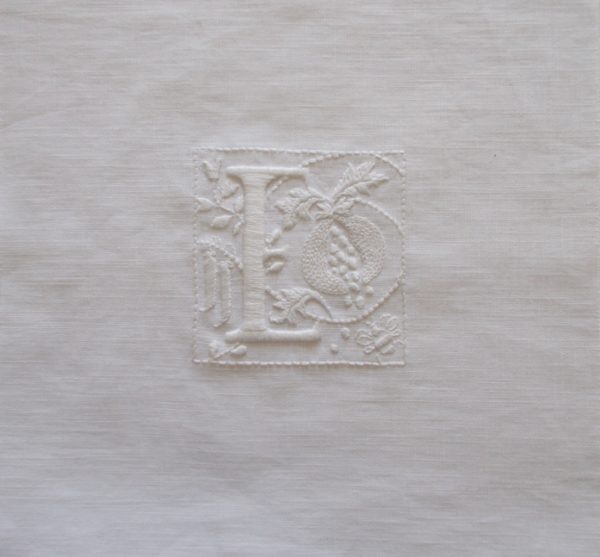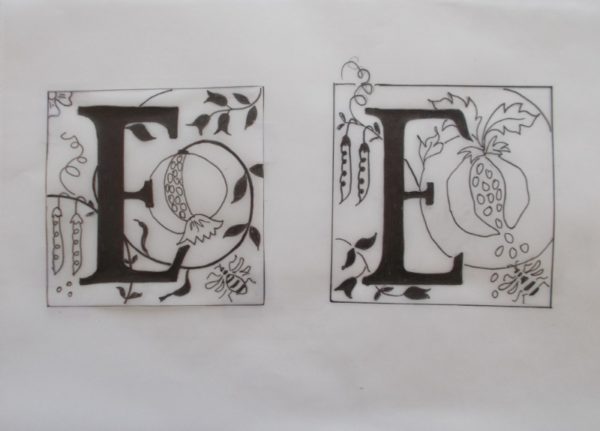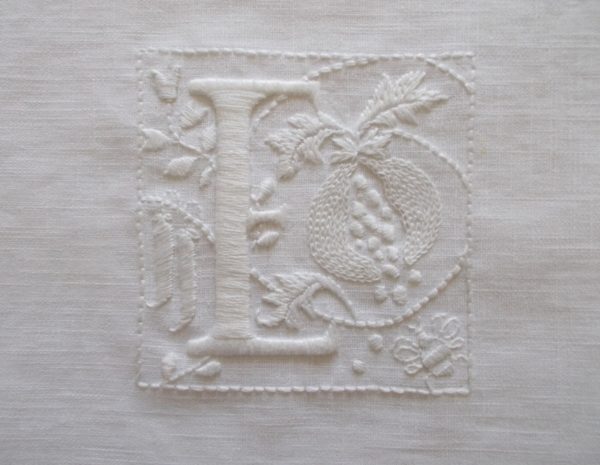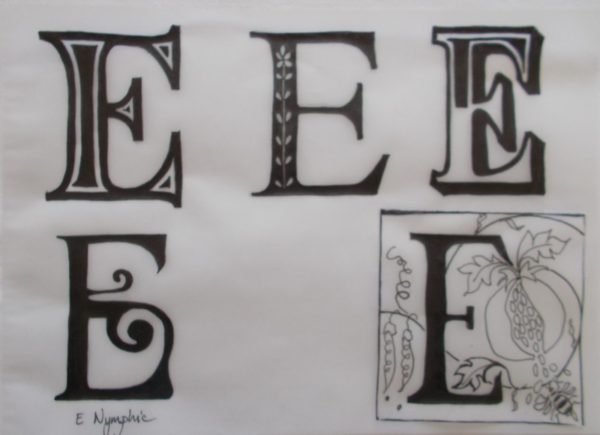
A whitework alphabet: letter E (hand embroidered by Mary Addison)
Oh yes, I thought, this week’s E embroidery can be a nice little pomegranate in the embroidery style of Elizabeth I.
When I was young, pomegranates were very special. They seemed to be available in about October round about the time of Nottingham’s Goose Fair. They looked rather gorgeously exotic, promised much but were somewhat disappointing – probably because we tended to eat them by laboriously picking out the jewelled seeds one by one with a safety pin! Full Middle East cuisine was yet to penetrate Nottinghamshire coal towns – we’d just about met pink grapefruit, avocados and french dressing (from the new big Sainsbury’s in Nottingham) but sprinkling salads with pomegranate seeds or using pomegranate molasses were decades away. Mind you I’m not passionate about the seeds even now and find them more gravelly than tasty, though the syrup Grenadine can be a fun addition to a cool drink on a hot day..

Sketches for E with pomegranate
The most common pomegranate’s binomial name is Punica granatum – Punica in reference to the scarlet colour of flowers and seeds, though Punica could equally refer to the plant’s Carthaginian origin, punic being the latin adjective for Carthaginian (think Punic Wars) and an early name for the pomegranate was indeed Malum punicum (cathaginian apple). Granatum refers only too accurately to the gritty quality of the seeds. It is of course the eating of six pomegranate seeds that got Proserpina (Gk: Persephone) into trouble in the underworld and landed her with her very own Brexit dilemma – the solution, 6 months in Hades and 6 months on earth, is fortunately not available to politicians in the real world!

A whitework alphabet: letter E (hand embroidered by Mary Addison)
The pomegranate spread via the Romans throughout southern Europe, rising to such importance in Spain that the city of Grenada was named for it with the fruit prominent on its coat of arms, just to underline the connection. Though not from Grenada, Catherine of Aragon adopted the pomegranate as her own device – its association with fertility and fruitfulness being just the thing for a young queen hoping to continue her husband’s royal line. I wrote about the pomegranate when I embroidered my own Elizabethan jacket and I quote from that blog post here, because I’d completely forgotten what I’d written there.
“Katherine and Henry’s marital difficulties are succinctly described in a small embroidery of 1529 by Anne Boleyn’s mother in which Anne’s symbol, the falcon, is depicted picking at Katherine of Aragon’s split pomegranate. Ouch, this is embroidery with the cut and thrust of a Private Eye cartoon and somehow more wounding for being made in a less transient medium than paper.
Katherine’s daughter, Mary I, then took over the symbol in memory of her mother. You might expect Elizabeth to have had enough of the pomegranate by the time she came to the throne. Indeed there is triumphalism in Elizabeth’s Armada portrait of 1588 where what looks like a pomegranate sits in front of an open window through which you can clearly see the Spanish fleet routed and in disarray. But by 1599, the ‘Hardwick’ portrait from Nicholas Hilliard’s workshop shows a couple of plump pomegranate fruits among all the other painted motifs clearly visible on the lower right of her dress.”
Hmm. Maybe by 1599 the queen’s eyesight was failing (she died in 1603, aged 70) – I’m not sure she would have madly embraced the image of the pomegranate with all that symbolic fruitfulness and fertility, both qualities which seemed to have missed being bestowed on the queen the day they were handed out … but as Nicholas Hilliard lived for 16 years after the queen died, it obviously didn’t amount to treason.

Es – some sketches of images found online
I now realise I’ve spent too much time looking at embroidered pomegranates and not enough at pictures of the real thing. The leaves are quite wrong. Mine are lobed when they should be lanceolate or spear shaped. I’ve also got the orientation completely wrong. The little coronet or calyx – the remains of the flower – should be at the opposite end to the stalk. Both of these things I did get right on one of my drawings but then I seem to have got carried away and did my own thing. It’s a good thing I’m no royal emblem maker as in one small embroidery I’ve not only insulted the queen but got the botany wrong too!!

7 Comments
I’m not sure the Elizabethans cared too much for botanical accuracy, as long as it made a good design. I quite agree about fresh pomegranates – although I love the juice!
Thank you for your reassuring comment Rachel – sometimes it’s easy to overthink these things.
The juice is definitely nicer than crunching through the fleshy seeds.
There’s usually a pomegranate left on Katherine of Aragon’s grave in Peterborough Cathedral.
How lovely!
This makes me smile. In the house I grew up in, there was a pomegranate tree in the yard. We kids ate them like crazy. Now I am older I am more like you, I find the fruit itself lackluster, but I am a huge fan of pomegranate molasses. It makes a wonderful component in a homemade salad dressing.
Having one in your garden sounds so exotic – I don’t think the British climate is at all right for pomegranates. Pomegranate molasses was quite a revelation for me – never heard of it until middle eastern cuisine became popular here but now it’s everywhere. I remember discovering hibiscus juice on a holiday in Egypt and wondering why we didn’t have that here – you do see it from time to time in specialist shops but it hasn’t hit the big time time like pomegranate juice.
Goo? way of expla?ning, annd pleasant piece of writing to get information concerning my presentation topic, which i am going to convey in academy.
Review my h?mepagge … David Bolno
2 Trackbacks
http://www.vct.ac.th
blog topic
Kaggle.Com
blog topic